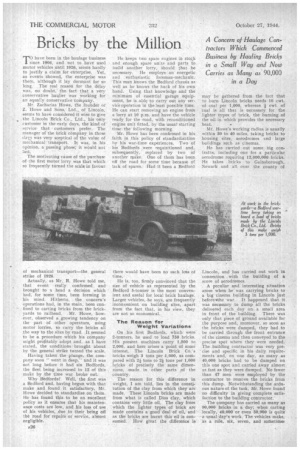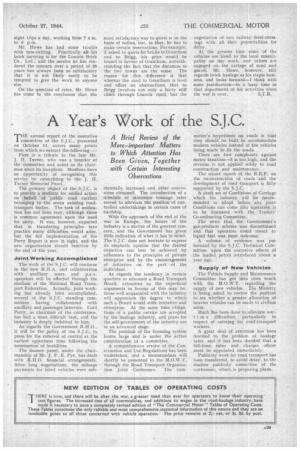Bricks by the Million
Page 28

Page 31

If you've noticed an error in this article please click here to report it so we can fix it.
have been in the haulage business since 1906, and not to have used motor vehicles until 1926, seems hardly to justify a claim for enterprise. Yet, as events showed, the enterprise was there, although it lay dormant for so long. _The real reason for the delay was, no doubt, the, fact that a very conservative hatilier was working for an equally conservative company. Mr. Zacharias Howe, the founder of Z. Howe and Sons, Ltd., of Lincoln, seems to have considered it wise to give
the Lincoln Brick Co., Ltd., his only a customer in the early days, the kind of service that • customers prefer. The manager of the brick company in those ilay_s was very sceptical of the value of mechanical 'transport. It was, in his opinion, a passing phase; it would not last.
The motivating reuse of the purchase of the first motor lorry was that which so frequently turned the scale in favour of mechanical transport—the general strike of 1926.
Actually, as Mr. R. Howe told me, that event really confirmed and brought to a head a decision which had, for some time, been forming in his mind. Hitherto, the concern's operations had, in the main, been con -fined to carting bricks from the brickyards to railhead. Mr. Howe, however, observed a _growing tendency on the part of other operators, using motor lorries, to carry the bricks all the way to the sites by road. It seemed to be a procedure which his company might profitably adopt and, as I have stated, the conditions brought about by the general strike turned the scale.
Having taken the plunge, the company soon " went in deep," and it was not long before it had six Bedfords, the fleet being increased to 12 of this make by the time war broke out.
Why Bedfords? Well, the first was a Bedford and, having begun with that make and found it satisfactory, Mr. Howe decided to standardize on them. He has found this to be an excellent policy as it ensures that his maintenance costs are low, and his loss of use of his vehicles, .due to their being off the 'road for repairs of service, almost negligible.
He keeps two spare engines in stoc,k and enough spare units and parts to build another lorry, should that be uecessary. lie employs an energetic and enthusiastic foreman-mechanic. This man knows the Bedford chassis as well as he knows the hack of his own hand. Using that knowledge and the minimum of essential garage equipment, he is able to carry out any service operation in the least possible time. He can start removing an engine from a lorry at 10 p.m. and have the vehicle ready for the road, with reconditioned engine unit fitted, by the usualstarting time the following morning,
Mr. Howe has been confirmed in his faith in this policy of standardization hy his war-time experiences. Two of his Bedfords were requisitioned and, subsequently, replaced by two of another make. One of them has been off the road for some time because of lack of spares. Had it been a Bedford there would have been no such loss of time, He is, too, firmly convinced that the size of vehicle as represented by the Bedford 5-tonner is the most convenient and useful for local brick haulage. Larger vehicles, he says, are frequently inconvenient on building sites, apart from the fact that, in his view, they are not so economical.
The Reason for Weight Variations On his first Bedfords, which were 2-tonners, he used to load 750 bricks. His present machines carry 1,500 to 2,000, and here arises a point of some interest. The Lincoln Brick Co.'s bricks weigh 3 tons per 1,000, as compared with 2f tons to 24 tons per 1,000 bricks of precisely the same dimensions, made in other parts of the country.
The reason for this difference in weight, I am told, lies in the constitution of the clay from which they are made. These Lincoln bricks are made from what is called Dias clay, which contains very little oil. The clay from which the lighter types of brick are made contains a good deal of oil, and as the bricks are burnt this oil is consumed. How great the difference is may Jae gathered from the fact that to burn Lincoln bricks needs 10 cwt.
of coal per 1,000, whereas cwt. of Coal is all that is necessary for the lighter types of brick, the burning of the oil in which provides the necessary heat.
Mi. Howe's working radius is usually within 30 to 40 miles, taking bricks to housing sites, aerodromes and large buildings such as cinemas.
He has carried out some big contratts, including one for a particular aerodrome requiring 12,000,000 bricks. He takes bricks to Gainsborough, Newark and all, over the county of
.Lincoln, and has carried out work in -connection with the building of a score of aerodromes.
A peculiar and interesting situation arose when he was carrying bricks to a big cinema building in Lincoln just befOre *the war. It happened that it was necessary to dump all the bricks delivered each day on a small area in front of the building. There was only that piece of ground available for the purpose and, moreover, so soon as the bricks were dumped, they had to be carried through the front entrance of the cinema and then conveyed to the precise spot where they were needed. The building contractor was very precise and specific in his daily requirements and, on one day, as many as 40,000 bricks had to be dumped on this one spot and carried away almost as fast as they were dumped. No fewer than 47 men were employed by the contractor to remove the bricks from this dump. Notwithstanding the arduous nature of the task, Mr. Howe found no difficulty in giving complete satisfaction to the building contractor.
The company has carried as many as 90,000 bricks in a day; when carting locally, 40,000 or even 30,000 is quite a usual ,day's work. The vehicles make, as a rule, six, seven, and sometimes eight trips a day, working from 7 a.m. to 6 p.m.
Me. Howe has had some trouble with rate-cutting. Practically • allt his brick carrying is for the Lincoln Brick Co., Ltd., and the service he has rendered the concern over a period of 28 yearshas always been so satisfactory that it is not likely easily to be tempted to give the work to anyone else.
On-the question of rates, Mr. Howe has come to the conclusion that the
most satisfactory way to quote is on the basis of radius, but, in that, he has to make certain reservations. For example, if asked to quote for bricks to Grantham and to Brigg, his price would be biased in favour of Grantham, notwithstanding the fact that the distances to the two towns are the same. The reason for this difference is that whereas the road to Grantham is level and offers no obstructions, that to Brigg involves not only a fairly stiff climb through Lincoln itself, but the negotiation of two 'railway level-crossings with all their potentialities for delay.
At the present time some of the vehicles are hired to the local municipality on day work, and others are engaged on the cartage of sand and gravel. Mr. Howe, however, still regards brick haulage as his staple business, and looks forward—I think with some justification—to a busy time in that department of his activities when the war is over. S.T.R.




















































